Catsailor.com Sails, Wings, and Winglets
Posted By: Inter_Michael Sails, Wings, and Winglets - 01/24/06 05:00 PM
Who hasnt noticed that most new airplanes out there today have 'winglets' attaced to the end of the wings? Some older planes are even being equipped with blended winglet technology. The result is less drag, more effiecient airflow,= less fuel burn.
If we subcribe that a sail is a wing, why not put winglets on top of the mast (some winglets extend both directions, up and down such as the A330). Would you not get the same result? Less Drag, more streamlined airflow?
Has this been tried, attempted, or is it nonsence?
Michael
Posted By: Rolf_Nilsen
Re: Sails, Wings, and Winglets - 01/24/06 05:17 PM
At the speeds sailboats are operating, I think the drag of the winglet would be far larger then the pressure leak it eventually might stop. The added weight that far up would not do much good for pitching and sideways stability either.
Also, sails and wings are not directly comparable. AoA for a sail is at best 25-30degrees whereas a wing has an Aoa of about 1 degree. The aspect ratio is also way off. All due to the constraints of the different environments the two crafts operate in.
Just my opinion..
Posted By: tigerboy Re: Sails, Wings, and Winglets - 01/24/06 08:43 PM
Michael,
If memory serves me correctly, Dennis Connor's Americas Cup catamaran "Stars and Stripes" (1988 challenge) had a hard wing sail with winglet "tips" at the top of the mastwing. The mastwing was built and tested by Burt Rutan's company, Scaled Composites in Mojave, CA. The mast tips were added to reduce vortex drag after wind tunnel testing.
Posted By: hobienick Re: Sails, Wings, and Winglets - 01/24/06 10:34 PM
I'm not sure if the savings in drag from the winglets will be all that advantageous when considering all of the other things on the boat that cause drag. You have all of the standing rigging, the trap wires, some of the running rigging, spin poles and socks (on some boats), the crew, and harware placed on the mast that will interrupt the airfoil shape... Basically and non-streamlined object on the boat.
Unless the "mastlets" give you a substantial increase in lift they really are not worth the expense. I believe the winglets on the airlines do not increase lift, but just reduce drag (and save about 10% in fuel consumption each flight) by reducing the draga for vortex generation as mentioned earlier.
I may be wrong, but I also don't remember seeing winglets on non-swept wing aircraft. This could be due to the fact that most swept wing aircraft are high speed, heavy aircraft who would benefit from the drag reduction.
Posted By: calcheck Re: Sails, Wings, and Winglets - 01/24/06 10:40 PM
what about a bouyant winglet- for a masthead bob- and accomplish 2 things at once
John R.
Posted By: catman Re: Sails, Wings, and Winglets - 01/24/06 10:48 PM
Michael,
Do a search on Winglets here. We talked about this a while back. Someone mentioned that it had been tried, not sure of the results. I believe the discussion was mostly about mast floats.
Posted By: catman Re: Sails, Wings, and Winglets - 01/24/06 10:56 PM
Posted By: Darryl_Barrett Re: Sails, Wings, and Winglets - 01/24/06 11:37 PM
"Winglets" were tried years ago on A class cats. The principle is sound and the reduction in drag due to the reduction in "tip vortex" is very measurable, the problem with a rotating mast is that to have the winglet as part of the mast, when it is rotated in relation to the sail the "plate" that forms the winglet has to be very large to still offer its effects to the sail on both tacks, the head of the sail has to be "squared" off and attached to the winglet plate by something similar to a "radial traveller" so that sail and the winglet form as near as possible a "one piece" tip. An offshoot of this unsuccessful "experiment" with winglets on masts that is being adopted more and more today was the early application of the square head sail. The same problems are not an issue on aircraft wings as both components are a “fixed” one part. The "Americas Cup" "J" class boats used the same principle at the bottom of the sail when they reduced (to advantage) the "vortex" or "equalisation of pressure" around the foot of their mainsail by using the "Park avenue" boom.
Posted By: catman Re: Sails, Wings, and Winglets - 01/25/06 02:58 AM
Tigerboy,
Here is a Pic of the winged beast with the vortex reducing tips.
So back to another thread dealing with mast floats that improve performance.....perhaps there is a way to add a similar tip to our boats. Seem more practical than a horizontal winglet type.
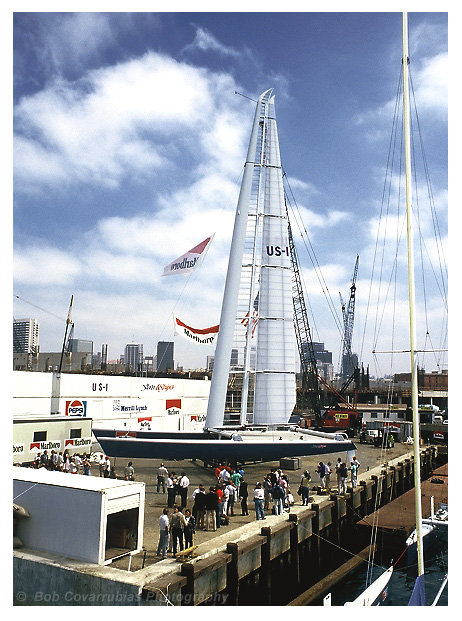
Posted By: Darryl_Barrett Re: Sails, Wings, and Winglets - 01/25/06 06:01 AM
And what a magnificent beast it truely was.
Where is it kept now?:
Posted By: scooby_simon Re: Sails, Wings, and Winglets - 01/25/06 09:43 AM
And what a magnificent beast it truely was.
Where is it kept now?:
Shame it was not the same shape or even anything like the boat that was challenged in.
It did turn the AC in to what it is now, so I suppose it was
progress.
Posted By: Rolf_Nilsen
Re: Sails, Wings, and Winglets - 01/25/06 09:57 AM
Shame it was not the same shape or even anything like the boat that was challenged in.
Wasnt that the point? Connor & co did not know anything about the boat the kiwis already had buildt in secret, before they challenged, except the length and width (and boy, was the kiwi boat wide!). The kiwis was obviously thinking "outside the box", and to catch up they needed something really spectacular. There was no requirement for a monohull in the challenge, so they looked at the fastest sailing vessels on the planet, foilers, planing skiffs, trimarans etc., but landed on a C-class on steroids as their best option. They did pretty good under the circumstanses, I would say.
Now, I dont think SS had a proper winglet. I would say they had a tapered top on their wing to reduce tip vortex. I understood winglets to be 90degrees or so to the foil, and their primary function to reduce pressure leakage? Secondary, reduce tip vortices?
Posted By: Jake Re: Sails, Wings, and Winglets - 01/25/06 01:08 PM
There were two of them - The first (a soft sailed version) was once owned by Steve Fossett and I believe is still active in the Great Lakes region in the US (Chicago, IL I believe). I think it was up for sale recently. The second went to a rich guy in Mexico who ran into some financial or legal trouble. The boat sat moored in the water for years (with the solid wing rigged). I saw a picture of it about a year ago where several of the wing panels were missing and boat was very neglected and a terrible state of disrepair. Apparently it came up for sale but I don't think anyone took it home.
Posted By: Mary Re: Sails, Wings, and Winglets - 01/25/06 01:58 PM
I am told the soft-sail Stars & Stripes is in Florida, currently owned by somebody in the Tampa/St. Pete area. I have notes about this and the name of the owner in one of my notebooks, but can't find it right now.
Posted By: Rolf_Nilsen
Re: Sails, Wings, and Winglets - 01/25/06 02:20 PM
There was a video posted somewhere of the soft sail SS blasting trough a fleet of monohulls. It was made by the new crew/owner, so it's definately sailing. I see that there is a copy on thebeachcats.com..
http://www.thebeachcats.com/modules...&file=index&req=getit&lid=49 Posted By: scooby_simon Re: Sails, Wings, and Winglets - 01/25/06 03:06 PM
Linky no worky

Posted By: sparky Re: Sails, Wings, and Winglets - 01/25/06 03:28 PM
The link worked for me...and it was fun to watch! It took some time to download, however.
Posted By: Jake Re: Sails, Wings, and Winglets - 01/25/06 03:44 PM
That rocks! The look on the guys face on the first monohull (28 or 30 footer) was priceless as she rolled through his lee doing probably three times his speed.
Posted By: hobiegary Re: Sails, Wings, and Winglets - 01/25/06 05:13 PM
So as not to hijack this thread, I posted my remark about winglet shaped mast head floats
here.
GARY
Posted By: hobiegary Re: Sails, Wings, and Winglets - 01/25/06 06:03 PM
Posted By: steveh Re: Sails, Wings, and Winglets - 01/25/06 07:02 PM
Gary, could you please post the link in the tinyurl link? For whatever reason, I can't get tinyurls.
Posted By: hobie1616 Re: Sails, Wings, and Winglets - 01/25/06 09:39 PM
Connor & co did not know anything about the boat the kiwis already had buildt in secret, before they challenged, except the length and width (and boy, was the kiwi boat wide!). The kiwis was obviously thinking "outside the box", and to catch up they needed something really spectacular.
I was in Auckland just after Conner lost the Cup to the Kiwis. I was walking around the port area and saw both Black Magic and the humungous challenger on the hard. The failed challenge boat made Black Magic look like a Sabot.
They were both close to the YC where the Cup was kept. I looked in the front door and it was sitting in a case just inside. That didn't last long because some nutter took a hammer to it.
Posted By: catman Re: Sails, Wings, and Winglets - 01/26/06 12:32 AM
I am told the soft-sail Stars & Stripes is in Florida, currently owned by somebody in the Tampa/St. Pete area. I have notes about this and the name of the owner in one of my notebooks, but can't find it right now.
When I was looking for the pic I read something about it being in Key West availible for charter. I didn't pay attention to date so that may have been a while ago. That would be the soft sail version.
Posted By: hobiegary Re: Sails, Wings, and Winglets - 01/26/06 12:40 AM
Posted By: catman Re: Sails, Wings, and Winglets - 01/26/06 01:04 AM
Shame it was not the same shape or even anything like the boat that was challenged in.
It did turn the AC in to what it is now, so I suppose it was progress. [/quote]
Fay (I think that was his name) got what he deserved.
Posted By: dacarls Re: Sails, Wings, and Winglets - 01/26/06 04:19 AM
1. Perhaps a mast-top winglet system would actually work in wave-piercing cats like A-class cats: Since pitching is not helpful to this concept, the wave-piercers seem to do it less.
2. Has anyone actually tried measuring pitching in wave piercers vs lets say- Marstrom conventional hull shapes?
This could be done from a digital video tape or a CD: at 1 second intervals, measure angle of mast rake for each boat. They should be sailing parallel to another to weather in appreciable waves for several minutes.
Put data on Excel sheet, (or by some magic maths which I do not possess)---determine which pitches less, and how much less!
Posted By: Tornado_ALIVE Re: Sails, Wings, and Winglets - 01/26/06 07:01 AM
SS soft sail and wing together
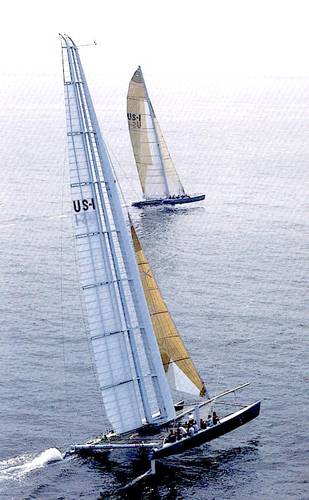
Posted By: Tornado_ALIVE Re: Sails, Wings, and Winglets - 01/26/06 07:08 AM
SnS soft sail
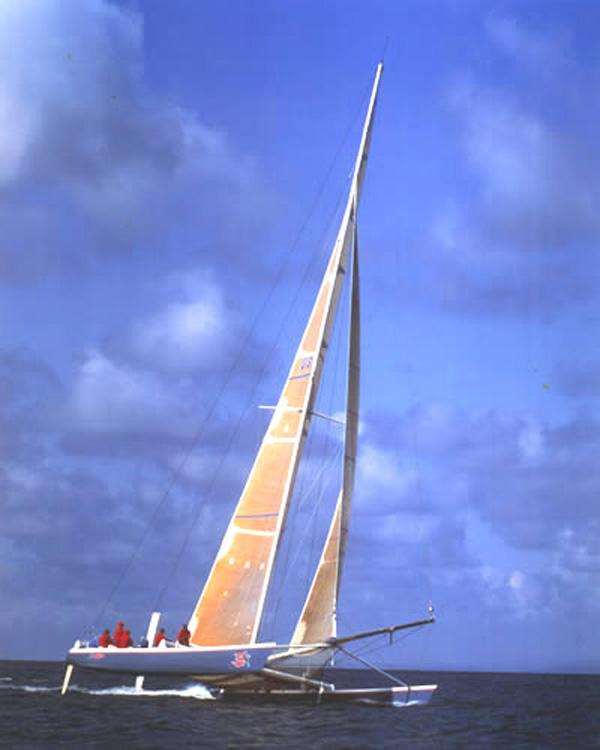
Posted By: Tornado_ALIVE Re: Sails, Wings, and Winglets - 01/26/06 07:12 AM
SnS wing sail as it sits today...... I downloaded these pics from an advertisement advertising it for sail..... Cannot remeber the site now.
Boat was used for chartered crusies and the boat is very run down..... The wing is riddled with spiders on the inside.
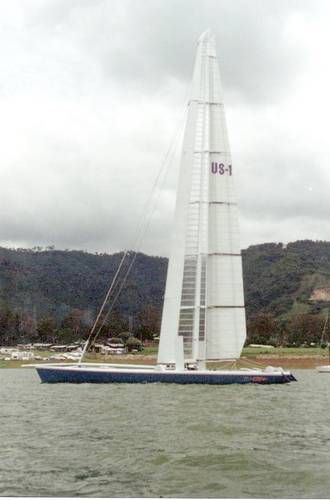
Posted By: Tornado_ALIVE Re: Sails, Wings, and Winglets - 01/26/06 07:14 AM
2nd
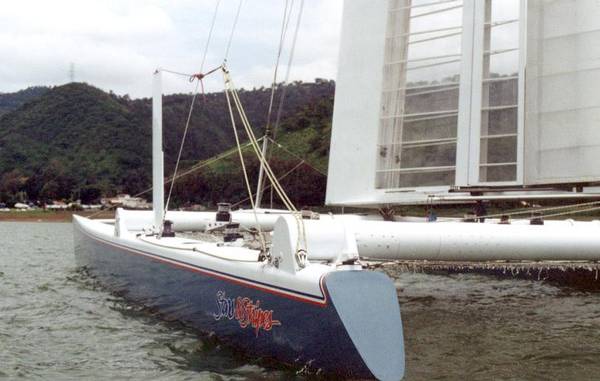
Posted By: Tornado_ALIVE Re: Sails, Wings, and Winglets - 01/26/06 07:15 AM
3rd
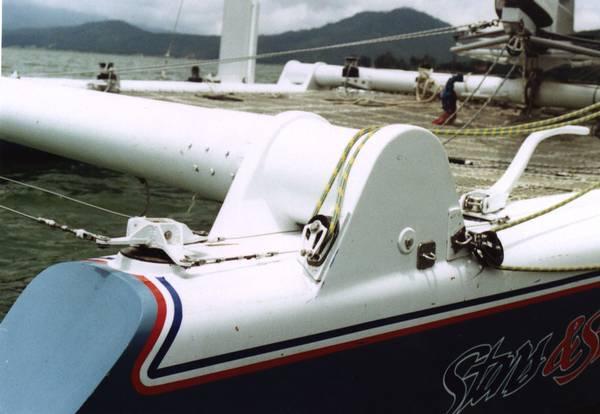
Posted By: MauganN20 Re: Sails, Wings, and Winglets - 01/26/06 03:29 PM
can't imagine that its too good for the boat to sit there with the hard wing up.
Imagine if a squall came down through there from the wrong direction... ouch!
Posted By: Nimrod Re: Sails, Wings, and Winglets - 01/26/06 03:41 PM
Winglets are vertical extensions of wingtips that improve an aircraft's fuel efficiency and cruising range. Designed as small airfoils, winglets reduce the aerodynamic drag associated with vortices that develop at the wingtips as the airplane moves through the air. By reducing wingtip drag, fuel consumption goes down and range is extended.
Aircraft of all types and sizes are flying with winglets -- from single-seat hang gliders and ultralights to global jumbo jets. Some aircraft are designed and manufactured with sleek upturned winglets that blend smoothly into the outer wing sections. Add-on winglets are also custom made for many types of aircraft.
Since the 1970s, when the price of aviation fuel began spiraling upward, airlines and aircraft manufacturers have looked at many ways to improve the operating efficiency of their aircraft. Winglets have become one of the industry's most visible fuel-saving technologies and their use continues to expand.
Winglets increase an aircraft's operating efficiency by reducing what is called induced drag at the tips of the wings. An aircraft's wing is shaped to generate negative pressure on the upper surface and positive pressure on the lower surface as the aircraft moves forward. This unequal pressure creates lift across the upper surface and the aircraft is able to leave the ground and fly.
Unequal pressure, however, also causes air at each wingtip to flow outward along the lower surface, around the tip, and inboard along the upper surface producing a whirlwind of air called a wingtip vortex. The effect of these vortices is increased drag and reduced lift that results in less flight efficiency and higher fuel costs.
Winglets, which are airfoils operating just like a sailboat tacking upwind, produce a forward thrust inside the circulation field of the vortices and reduce their strength. Weaker vortices mean less drag at the wingtips and lift is restored. Improved wing efficiency translates to more payload, reduced fuel consumption, and a longer cruising range that can allow an air carrier to expand routes and destinations.
To produce as much forward thrust as possible, the winglet's airfoil is designed with the same attention as the airfoil of the wings themselves. Performance improvements generated by winglets, however, depend on factors such as the basic design of the aircraft, engine efficiency, and even the weather in which an aircraft is operating.
The shapes and sizes of winglets, and the angles at which they are mounted with respect to the main wings, differ between the many types and sizes of aircraft produced but they all represent improved efficiency. Throughout the aviation industry, winglets are responsible for increased mileage rates of as much as 7%.
Aircraft manufacturers and makers of add-on winglets have also reported improved cruising speeds, time-to-climb rates, and higher operating altitudes.
The use of winglets throughout the aviation industry in the U.S. and overseas is constantly growing. Winglets now appear on powerless hang gliders soaring above mountain ridges and from seaside cliffs. Sailplane builders around the world have included blended winglets to their designs and the sleek, graceful gliders are silently soaring farther than ever Corporate-size Learjet's were the first commercial aircraft to use winglets. Now, several decades later, winglets are incorporated into the designs of many other business jets such as Gulfstreams and the Global Express: a new aircraft built by Lear's parent company, Bombardier.
Retrofitting winglets to existing business jets is also a fast-growing market within the aviation industry itself. Many winglet marketing firms report their products help increase aircraft roll rates and lower approach and takeoff speeds.
Winglets are now quite common on large jetliners and many tower as high as six feet. The first big jetliner to carry the innovation into the air was the MD-11, originally designed and built by McDonnell-Douglas and now part of the Boeing aerospace family. Other Boeing aircraft flying with winglets are the 747-400F, the version currently being built, Boeing BBJ business jets which are custom-built 737s, and the C-17 military transport. Boeing is also offering winglet options on new advanced models of the 737 series of passenger jets.
Most prominent foreign carrier of winglets are the many models of the 300 series of jetliners designed and built by Airbus Industries. The future A380 Airbus, a huge intercontinental double-deck jetliner now under development, will also utilize winglet technology.
The first homebuilts with winglets on the general aviation market were the Vari-Eze and Long-Eze models designed by Burt Rutan, a pioneer in aircraft design innovations. Now, the majority of homebuilt aircraft coming out of shops, garages, and hangars around the world display winglets of varying shapes and sizes.
Posted By: Mary Re: Sails, Wings, and Winglets - 01/26/06 03:44 PM
I had an e-mail discussion a while back with Dave Ellis. I had asked him his opinion about the possibility of masthead floats being designed so they actually give lift, and the possibilities of having fixed or articulating masthead winglets (which he refers to as end plates). Here is one of his responses, and I found it very interesting:
Horizontal airfoils. I like it.
In the late 60s the A-cats and C's at Cabrillo Beach YC, Long Beach, CA, used "end plate" booms. Some used a wishbone down low with Dacron filling it in. Others used a normal, for the day, boom with Ocumme ply wings. We made sure that it was very slightly HIGHER at the clew. This was not to lift the boat, but to compress the air and make the air lift. If the Park Avenue Boom thing angled down, we felt it would blanket part of the bottom of the sail.
The old Suicide class (ask Bill Roberts) was anything-goes in monohull, but with only 125 square feet of actual sail area, including mast. It became very efficient, using an A-cat style mast and wishbone main, 1950's and 60's materials, of course. Tried was an end plate on the top of the mast. Again, it was more for reducing tip vortex than lift, although it was angled up on the front for the same reason the boom was angled down on the tack. The class ruled that they had to count the tip deflector as sail area, so it was quickly abandoned.(Most booms on dinghies are faster with the boom lower at the clew, It makes for leading edge foot, instead of trailing with its tip vortex and loss of pressure under the boom.)
On the Suicide, wind resistance on the spars and hull was a major design consideration. Many of the hulls looked like missiles or long cigars to try to cut the wind. It helped.
I'm no scientist. I do teach racing for Offshore and North U so have lots of feedback from clients. I think a wing would work IF it were not counted sail area.
In windsurfing, the sailor can re-align the sail to near-horizontal and catch air to a remarkable degree. But it also slows the board so that when it floats to the water it is barely moving ahead. If he had two sails, one to go and one to lift, hmmm. Kites are the obvious answer. I'm trying to figure out how to control it alone while sailing single-handed.
Of course, a well-designed asymmetrical chute lifts our bows. Most of the time.
I have built a Formula 14 as a test-bed. I really don't care about a Portsmouth # for it. Hydrofoils will be later. I want to try it the way it is first.
But you have made me think about a wing at the top of the mast that I can also use to keep the windsurfing sail from de-powering as fast by tiny blocks and lines leading down ala C-cat wing masts to keep the fathead leach from falling off so much. The top-mast wing would help the tip vortex thing and maybe lift the boat a bit. Kites do. Or maybe the drag would negate any advantage.
We who care not about design rules get to experiment and spend our time and money!
Dave Ellis
Posted By: Inter_Michael Re: Sails, Wings, and Winglets - 01/26/06 08:37 PM
Thank you very much for all the info. Great stuff. I like the idea of using something more 'aerodynamic' than the traditional hobie bob 'football' at the masthead.
Michael
Posted By: DVL Re: Sails, Wings, and Winglets - 01/28/06 12:10 AM
Not only for airplanes. Big butt Fans has added wing tip vortex's to the large overhead fans used in industry to cool factories. These fans operate at lower speeds, generate more air flow. Apparently the engineers have tested with software, wind tunnels, and independent testing.
www.BigAssFans.com Posted By: paul57man Re: Sails, Wings, and Winglets - 01/31/06 04:35 AM
I have used endplates on my RC boat they seem to greatly improve the sail's power, even if the head is twisting off a bit. I even made up a big carbon one (650mm) for my taipan but have never got a chance to rig it up yet.
Posted By: Jalani Re: Sails, Wings, and Winglets - 01/31/06 09:25 AM
Picture please?

Posted By: Luiz Re: Sails, Wings, and Winglets - 01/31/06 03:56 PM
The concept of an automatic inflation chicken float attached to a square top main and shaped as a winglet has been discussed a couple of years ago in this forum.
The idea was to improve safety and the challenge remains the same: how to maintain or improve performance through the winglet shape, given the losses due to more weight in a bad place (high).
If my memory doesn't fail, the chosen inflation system was a paintball gas cartridge and the winglet-float would be attached to the sail instead of the mast to facilitate maintenance.
Luiz
Posted By: Anonymous
Re: Sails, Wings, and Winglets - 02/01/06 02:13 PM
This is why the genoas on racing mono hulls are so annoyingly low. The deck acts like a winglet to separate the pressures until the trailing edge.
Matt
Posted By: Jake Re: Sails, Wings, and Winglets - 02/01/06 10:26 PM
hmmm...never thought of that. I always knew that the deck sweeping jibs and genny's were higher performance but I never really wondered why (besides the additional sail area)...thanks.
Posted By: Wouter Re: Sails, Wings, and Winglets - 02/02/06 10:49 AM
It is either that or the fact that alot of monohull class rules and handicap rules are written in a way that only used the area of the triangle between mast, deck and forestay. This same rule resulted also in designs with small mainsails and huge overlapping genua's. These setups were ONLY faster because the area of the overlap was not taken into the handicap rule while the total mainsail area was. If the rules were written to use actual area's then a larger mainsail and smaller jib would have proven to be faster.
Guys, alot of design features are the result of how the class/handicap rules were written not per se because it is aerodynamically better.
Wouter
Posted By: Rolf_Nilsen
Re: Sails, Wings, and Winglets - 02/02/06 11:58 AM
End plate effect is accepted dogma for deck sweeping jibs.
To take it one step further. Why doesnt cruisers have deck sweeping jibs? Well, some do, but most of them retrofit roller furling, and recessing the furling drum is a major job. Newer cruisers sometimes have the furling drum recessed, but usually only in the higher price range. Another major problem with deck sweeping jibs in cruisers is lack of visibility, and building lasting opaque sails for cruisers is hard/expensive.







